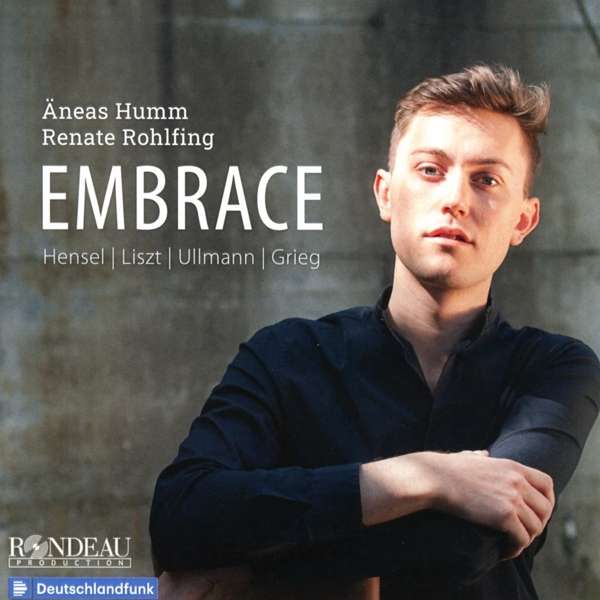Der Schweizer Bariton Äneas Humm präsentiert auf dem Album Embrace eine interessante Auswahl von Raritäten des Kunstliedrepertoires, doch die eigentliche Überraschung ist der Interpret selber. Wir entdecken mit Äneas Humm einen exzellenten Liedinterpreten, der die Lieder nicht nur vom Kopf her verstanden hat, sondern auch mit seiner Musikerseele. Die sehr unterschiedlichen Lieder zeigen Humm als höchst einfühlsamen Sänger, emotionaler, emphatischer, affektreicher als viele seiner Kollegen.
Seine klare Stimme ist flexibel und erlaubt ihm ein außergewöhnliches Farbmanagement und eine feine Nuancierungskunst, die einer stupenden Ausdrucksvielfalt führen. Textverständlichkeit ist für ihn oberstes Gebot. Er ist sich in jedem Lied des Textes bewusst und er gestaltet ihn mit größter Intensität, dramatisch, ohne aber je zu überdramatisieren.
Auch stilistisch weiß er die Unterschiede zwischen Fanny Hensel, Franz Liszt, Edward Grieg und vor allem Viktor Ullmann herauszuarbeiten, dessen Zyklus ‘Der Mensch und sein Tag’ auf Texte von Hans Günther Adler entstand, einem Theresienstädter Mithäftling, der den Holocaust im Gegensatz zu Ullmann überlebte und dessen Manuskripte in England aufbewahrte.
Hinzukommt, und das ist wohl das Wichtigste, eine Fähigkeit zum Kommunizieren, ein Charisma, das den Hörer unmittelbar impliziert. Humm macht sich die Liedtexte zu eigen und trägt sie mit voller Überzeugung vor, er identifiziert sich also mit dem Text wie auch mit der Musik und greift dadurch auch sehr stark in die Kommunikation zwischen dem Dichter, dem Komponisten und dem Rezipienten ein.
Die Pianistin Renate Rohlfing begleitet den Sänger konstruktiv am manchmal von der Aufnahme her zu sehr bevorteilten Klavier.
Swiss baritone Äneas Humm presents on the album Embrace an interesting selection of rarities of the art song repertoire, but the real surprise is the performer himself. We discover in Äneas Humm an excellent song interpreter who has understood the songs not only from the head, but also from his musical soul. The very different songs show Humm as a highly sensitive singer, more emotional, more emphatic, more dramatic than many of his colleagues.
His clear, well articulating voice is flexible and allows him an extraordinary color management and a fine art of nuance, resulting in a stupendous variety of expression. Lyrical comprehensibility is his top priority. He is aware of the text in every song and he shapes it with the greatest intensity, dramatically, but without ever overdramatizing.
Stylistically, too, he knows how to bring out the differences between Fanny Hensel, Franz Liszt, Edward Grieg and, above all, Viktor Ullmann, whose cycle ‘Der Mensch und sein Tag’ is based on texts by Hans Günther Adler, a fellow Terezin inmate who, unlike Ullmann, survived the Holocaust and whose manuscripts were kept in England.
Added to this, and probably most important, is an ability to communicate, a charisma that immediately implicates the listener. Humm makes the song texts his own and performs them with full conviction, thus identifying himself with the text as well as with the music, and thus also intervenes very strongly in the communication between the poet, the composer and the listener.
The pianist Renate Rohlfing accompanies the singer constructively on the piano, sometimes a bit advantaged in the not so well-balanced recording.




















